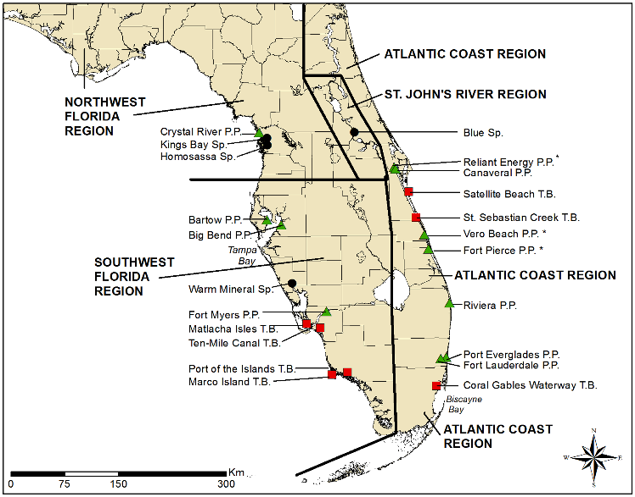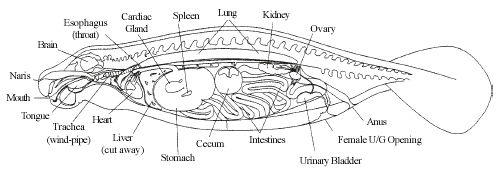Are you a teacher or other group interested in learning more about manatees? Please reach out to us about our manatee lesson plan and/or in-person presentation all about manatees (manatee@broward.org)
Manatee 101
Manatees are large, slow-moving marine mammals of the Order Sirenia. The Florida manatee (Trichechus manatus latirostris) is a subspecies of the West Indian manatee (Trichechus manatus). There are two other species of manatees, the Amazonian manatee, and the West African manatee.
The average Florida manatee is about 10 feet long and weighs close to 1,200 pounds. Manatees can reach up to 13 feet in length and weigh 3,500 pounds. Female manatees tend to be larger than males. Their calves weigh around 66 pounds and are 4 feet long at birth. Manatees consume about 20% of their body weight in vegetation daily which translates to an average 4 - 8 hours of foraging. Despite all of this eating and their size, manatees actually have very little fat on their bodies. Because of this, they have trouble staying warm and during wintertime, depend on external sources of heat (warm water refuges) to thermoregulate.
The Florida manatee exhibits high site fidelity, meaning that they return to the same warm water refuges year after year. Manatee management units are broken up by region as indicated in the map below. Generally speaking, manatee regions over-lap some, but rarely do manatees move between coasts. Warm water refugia utilized by manatees are indicated on the map below; green triangle are power plants, black dots are natural springs, and red squares are passive thermal basins. Passive thermal basins are bodies of water where cooling occurs slowly so the body of water retains relative warmth for a period of time.

Manatee Morphology & Biology

A manatee’s mammary glands (milk glands) and teats (one per side) are located behind the fore limbs. The milk glands have no storage sacs (like cattle and goats) so manatee calves suckle frequently at short intervals. Manatees will nurse for 1 - 2 years.

The manatee swims with up and down motions of its body and fluke. This is similar to the swimming motions of the cetaceans (dolphins and whales) but is unlike the side to side swimming motions of fish and seals. Manatee muscles have little myoglobin (muscle hemoglobin) when compared to other diving mammals—this means manatees cannot store as much oxygen as seals and dolphins, which is reflected in their relatively short (8-15 minute) and shallow (10-20 feet) dives.
A manatee’s teeth are similar to the molars of some other mammals and are located in the back half of the lower and upper jaws. Manatee teeth are unique in that they are replaced horizontally, as opposed to vertically as in most other mammals. Tooth replacement is continuous (polyphyodont) throughout their lives, as opposed to that of other mammals which replace a single set of teeth once in a lifetime (diphyodont).
The ribs of the manatee arch up to allow the lungs to be positioned much higher along the vertebral column than is found in most other mammals. Their ribs and other long bones lack marrow cavities, which produces a dense and relatively heavy skeleton. Marrow, which produces red blood cells, is mostly restricted to the centra (bodies) of the vertebrae and possibly the sternum. Manatees do not have hind limbs. Their pelvic bones are vestiges of the more complex structures of their ancestors. The pelvic vestiges are attachment sites for muscles.

Like the horse, manatees are hind-gut digesters as opposed to fore-gut digesters (like the cow). This means that more of the digestive processes occur further along the intestinal tract. It takes about 7 - 10 days for material to pass through the manatee’s digestive system.
A manatee's blood is very important in transporting heat and regulating body temperature.
Manatee lungs are unique! Unlike other mammal lungs that are positioned around the heart and extend backwards over the stomach and liver, manatee lungs are flattened and elongated. The lungs extend horizontally along the back almost to the anus. The branching pattern of the bronchi (the primary air tubes) and blood vessels is simpler in manatees than in other mammalian lungs.
Manatees live in both fresh and salt water. Their kidneys filter blood to control levels of salt and to maintain water balance. The urinary bladder stores urine until it is advantageous to dump it into the environment.
Manatees have relatively small brains when compared to other mammals of their size. Their brains are very smooth, having few of the surface ‘folds’ that are associated with higher intelligence in other mammals.
For more information about the manatee brain, visit The Brain of the Florida Manatee Web Site.
Sources for the text and photos for this page are the Florida Fish and Wildlife Conservation Commission (FWC), peer-reviewed journal articles, and The Florida Manatee by Reep and Bonde. For more information, visit FWC’s Web site featuring frequently asked questions and answers about manatees.
